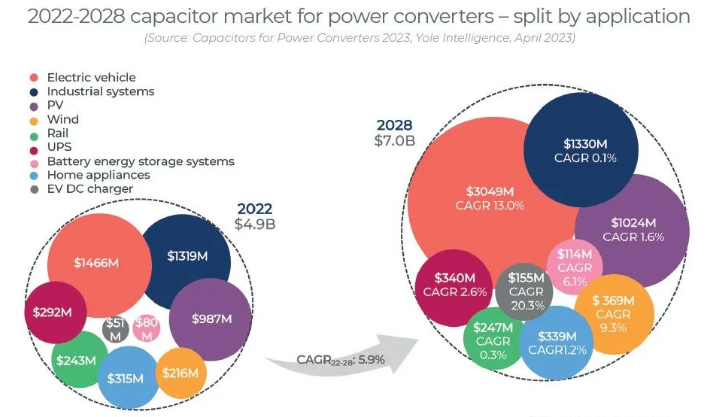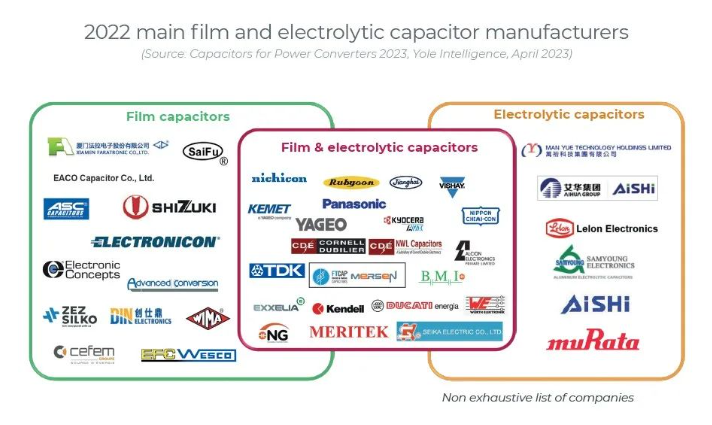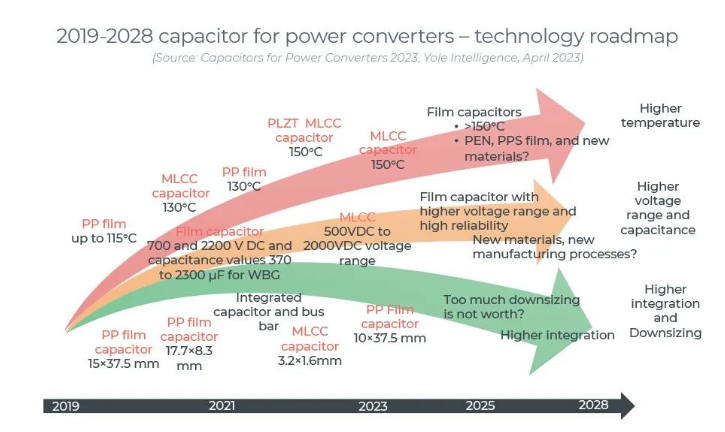Capacitor costs will account for approximately 10% of total power converter costs by 2022. This ratio is increasing as the number of expensive film capacitors increases. This percentage increases with system power level.
The overall capacitor market for power converters will grow from approximately $4.9 billion in 2022 to $7.0 billion in 2028, a 5.9% increase in 2022-2028. Film capacitors will see the most significant growth, with a market size of approximately USD 3.9 billion by 2022. Electrolytic capacitors and multilayer ceramic capacitors (MLCC) are mainly used in the medium and low voltage range, with a CAGR of 5.7% and 5.1% in 2022-2028, respectively.
The market share of xEVs in power capacitors will increase from 29% in 2022 to 44% in 2028. Therefore, many capacitor companies are willing to expand their business and pay attention to the current and future needs of the automotive industry.
Leading capacitor companies include Nippon Chemi-Con, Murata, Kyocera/AVX, and TDK in Japan; Vishay in the US; and Yageo/KEMET in Taiwan.
Many capacitor manufacturers such as TDK, Kyocera AVX and Yageo produce all types of capacitors, namely film, electrolytic and MLCC. However, some only focus on a few types of capacitors. For example, Samsung Electro-Mechanics and Taiyo Yuden only have MLCCs, while Nichicon and Rubycon produce film and electrolytic capacitors.
Many leading capacitor manufacturers such as Nichicon, TDK and Kemet are vertically integrated and also produce capacitor components such as metal foil for film capacitors and metal foil for electrolytic capacitors. Meanwhile, some manufacturers, such as Samsung Electro-Mechanics and TDK, use their own systems in vertically integrated supply chains.
Many capacitor companies have operations and manufacturing capabilities in multiple countries. Countries like China, India and Latin America are less expensive to manufacture than in Europe or Japan. On the other hand, local manufacturing offers advantages such as better access to local incentives, easier access to customers involved in specific applications, higher flexibility and responsiveness to customer needs, etc.
Mergers and acquisitions (M&A) have been on the rise over the past few years to add new product lines, improve profitability, acquire more customers, or eliminate competition. For example, through the acquisition of KEMET, Yageo acquired many new products and customers, and greatly expanded its business in North America.
In the power capacitor industry, thin film technology remains the mainstream for DC link applications – however, some markets with high cost pressures often return to electrolytic capacitors.
For snubber applications, thin film and MLCCs are commonly used. Multilayer Ceramic Capacitors (MLCCs) are used in low and medium voltage ranges such as home appliances and mild hybrid electric vehicles. Film capacitors are used in medium and high voltage ranges, such as all-electric vehicles, railways and wind energy.
The most important trends in power capacitors include:
The xEV sub-segment is gaining market share while finding suitable solutions to address numerous challenges associated with xEV applications such as high power density, integration, high voltage range, reliability under frequent thermal cycling, and vibration.
There is a growing demand for compact capacitors, e.g. for xEV applications.
There is a growing demand for capacitors that can withstand higher temperatures, both at the junction and in hostile operating environments.
The innovative system trend of xEVs may increase the demand for high temperature DC link capacitors. Dielectric films such as polypropylene (PP) and polyethylene terephthalate (PET) improve capacitor performance, such as increased energy density and ability to withstand high temperatures. Therefore, in order to meet the specific requirements of xEV, dielectric film manufacturers such as Toray, Shin-Etsu Film, and Fuwei Film, as well as capacitor manufacturers, play a vital role in improving capacitor performance.
Post time: Apr-26-2023



